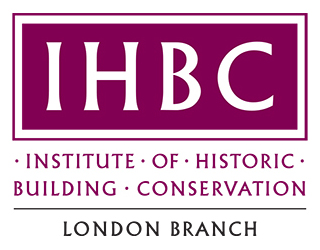
Thursday 4th October 2018

Speakers
David McDonald
David McDonald is a heritage consultant, specialising in training other built environment professionals. He was, until late 2011 Conservation and Design Team Leader at the Royal Borough Kensington, a post he held for over twenty years. David previously worked as a town planner at the London Borough of Camden during which time he completed the Diploma in Conservation at the Architectural Association. Formerly a member of the Association of Conservation Officers, he joined the IHBC at its inception and has been Chair of its London Branch since 2004.
Christopher Costelloe
Christopher Costelloe has been the Director of the Victorian Society since 2012, following two years as a Caseworker there. He is also a qualified stonemason, having completed an apprenticeship in Somerset. He has also worked as a regeneration consultant and for an investment bank. Sketching Norman Shaw’s Grimsdyke at the age of seven kindled his interest in architecture, which was aided by reading History at Durham in the shadow of the great cathedral.
Ian Morrison
Ian Morrison was appointed Director of Planning at Historic England in July 2017 to help shape the future direction and strategies of the organisation and lead the delivery of its statutory and non-statutory planning functions both nationally and locally. Ian was previously Chief Executive of the Architectural Heritage Fund where he expanded the charity’s advice, grants and loan services to help meet the growing demand of enterprising communities that wish to repair and re-use historic buildings they value. Prior to joining the AHF, Ian was Head of Historic Environment at the Heritage Lottery Fund (HLF), where he held the lead UK policy role for the historic environment since 2008 and introduced HLF’s Heritage Enterprise and Grants for Places of Worship grant programmes. Trained as an archaeologist, his early career was spent with English Heritage, where he amassed 15 years’ experience working in a variety of roles in London and the South West region. He is a former serving member of the Cathedrals Fabric Commission for England, the Prince’s Regeneration Trust Advisory Panel and Historic England’s Expert Advisory Group and is currently a member of the DCMS-sponsored Cultural Development Fund Advisory Panel.
Matthew McKeague
Matthew McKeague joined the AHF in October 2017 from the Churches Conservation Trust (CCT) where, as Director of Regeneration, he led a highly successful team developing innovative new uses for historic churches. He also developed the Trust’s work on social impact measurement, including its first ‘Theory of Change’, and developed a consultancy service to enable churches to access the CCT’s expertise. Since joining the AHF Matthew has been securing investment for the heritage sector through a new Heritage Impact Fund and has been evaluating the work of the charity as it prepares its new strategy for 2019-22. Matthew also has considerable experience in the third sector; he was trustee and chair of the environmental social enterprise Forest Recycling Project for six years.
Lizzie Glithero-West
Lizzie Glithero-West took up her role as Chief Executive of the Heritage Alliance in 2016 having previously been adviser to Baroness Neville-Rolfe at the Department for Culture, Media and Sport (DCMS). Her career has been mainly in the civil service, initially with the Office of the Deputy Prime Minister, but since 2004 with the DCMS. She has expert knowledge of a wide range of policy areas including archaeology, heritage protection, gambling and tourism. Lizzie has also spent time as Private Secretary to the Permanent Secretary, as Head of Logistics at DCMS, and on secondment to English Heritage, and to the National Museum Directors’ Council.
Sophie Jackson
Sophie Jackson is Director of Research and Engagement at MOLA (Museum of London Archaeology). For most of her career she has worked as a project manager, designing and coordinating archaeological fieldwork and research in London’s historic core. She has led teams on key sites within central London and most recently she has worked with Bloomberg on the archaeological excavation at the site of their new European headquarters and on the reconstruction and display of the London Temple of Mithras, first discovered on the site in 1954. She now overseas all of MOLA’s research and wide-reaching archaeological engagement projects.
Luke Moloney
Luke Moloney is an architect in private practice, founding trustee of Building Preservation Trusts in Dumfries and Galloway, and Chair of Dumfries Historic Buildings Trust. Luke is passionate about the protection, care, conservation and restoration of historic buildings. Having campaigned to save Moat Brae, a listed Regency Greek Revival town house, from demolition, a Trust was established for its acquisition and restoration. Luke founded the Dumfries Historic Buildings Trust in 2011. In March 2018, the Trust acquired Rosefield Mills, another Building on the Buildings at Risk Register. To achieve this the Trust engaged with the local community to demonstrate there was public support and to develop plans for the future of the building.
Lorna Blake
Lorna Blake is a qualified Chartered Surveyor jointly employed by the London Legacy Development Corporation, London Borough of Hackney and London Borough of Tower Hamlets. As Developer and Business Engagement Manager for Hackney Wick and Fish Island, Lorna’s main remit is to help existing businesses stay in the area as extensive development plans progress. Working across the three authorities with the Planning, Property and Regeneration teams, she advises on issues that directly impact local businesses including relocation strategies and section 106 obligations. Prior to this role, Lorna worked for a large property firm and private developer in London and the South East.
Esther Everett
Esther Everett is an architect with extensive experience in urban design, landscape architecture, public realm and architecture. After working in the private sector, including at Hawkins Brown, Fluid and Meadowcroft Griffin Architects, she joined Design for London in 2010 and has since been ensuring high quality design across regeneration projects including at the London Legacy Development Corporation, Old Oak and Park Royal Development Corporations. She provides high quality strategies and architectural design proposals to ensure good pieces of integrated city are established within a context of growth. She has led on the design and delivery of a number of public realm and cultural projects in Hackney Wick and Fish Island to help protect and improve the resilience of the local artistic and creative community.
Stuart Taylor
Stuart Taylor is a landscape architect and founder member of the Ivy House Community Pub Ltd. The Ivy House was the first successful Asset of Community Value nomination in the country and the first cooperatively owned pub in London; the grade II listed pub is now in its sixth year of trading under collective ownership. Stuart has worked in conservation and landscape planning for over ten years, first as caseworker for The Georgian Group before joining Historic England’s Heritage at Risk Team. He currently advises on all aspects of landscape planning for Barton Willmore.
Deborah Saunt
Deborah Saunt, as Director of the architecture, urbanism and research practice DSDHA, has worked on several mixed-use, residential and cultural schemes, as well as a number of civic buildings and public spaces in the UK. She is currently leading on the re-design of the public realm around the Royal Albert Hall in South Kensington as well as on the restoration of Alison & Peter Smithson’s iconic Economist Plaza. Deborah recently completed a PhD and Research Fellowship in the Built Environment, and now leads research projects within her studio. She is also a member of various advisory boards and judging panels. She has taught widely in the UK, Switzerland, USA, Iceland and, most recently, in Spain.
